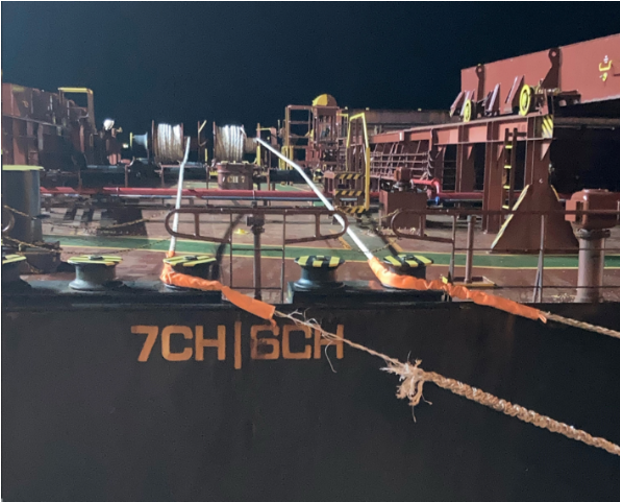CHIRP: Crew vigilance prevents mooring incident
What happened
CHIRP – the Confidential Human Factors Incident Reporting Programme – has shared an event in which the careful vigilance of vessel crew prevented a mooring incident. A long, low-amplitude swell was causing a steady yawing and rolling motion of up to around 1.2m from the wharf on a 93,000-tonne deadweight bulk carrier alongside. During this time, a forward spring line running over the edge of the shipside roller fairlead began interacting with another mooring line causing significant abrasion damage.
What went right
Good monitoring of the lines by the vessel crew picked up the damage. There was good communication on the vessel and between the vessel and the terminal. The lines were replaced and re-run by the ship’s crew before they parted.
What went wrong
It was observed by CHIRP that “the design of the roller fairleads was not optimised to prevent contact with the sheer strake. Additionally, like many vessel spring lines, they can be susceptible to abrasion when environmental conditions at the port result in excessive movement.”

Lessons learned
- The importance of good communication and good teamwork;
- Safety by design – CHIRP notes that many mooring fixtures and fittings are applied to the ship’s structure to meet compliance with the ship’s design requirements. Still, many are not properly designed to ensure that their directional lead is optimised to prevent abrasion of the line and maximising their resistance to the applied force on the line. How well do your mooring arrangements work? Do you have to use other rollers to obtain a better lead?
CHIRP is a charity providing an independent, confidential incident and near-miss reporting programme to improve safety at sea for mariners worldwide. CHIRP investigates every report and publishes anonymised findings to raise awareness of safety issues. IMCA works closely with the CHIRP Maritime Advisory Board.
Lessons learned
- The importance of good communication and good teamwork;
- Safety by design – CHIRP notes that many mooring fixtures and fittings are applied to the ship’s structure to meet compliance with the ship’s design requirements. Still, many are not properly designed to ensure that their directional lead is optimised to prevent abrasion of the line and maximising their resistance to the applied force on the line. How well do your mooring arrangements work? Do you have to use other rollers to obtain a better lead?
Members may wish to refer to
Safety Event
Published: 15 August 2023
Download: IMCA SF 20/23
IMCA Safety Flashes
Submit a Report
IMCA Safety Flashes summarise key safety matters and incidents, allowing lessons to be more easily learnt for the benefit of all. The effectiveness of the IMCA Safety Flash system depends on Members sharing information and so avoiding repeat incidents. Please consider adding [email protected] to your internal distribution list for safety alerts or manually submitting information on incidents you consider may be relevant. All information is anonymised or sanitised, as appropriate.
IMCA’s store terms and conditions (https://www.imca-int.com/legal-notices/terms/) apply to all downloads from IMCA’s website, including this document.
IMCA makes every effort to ensure the accuracy and reliability of the data contained in the documents it publishes, but IMCA shall not be liable for any guidance and/or recommendation and/or statement herein contained. The information contained in this document does not fulfil or replace any individual’s or Member's legal, regulatory or other duties or obligations in respect of their operations. Individuals and Members remain solely responsible for the safe, lawful and proper conduct of their operations.
